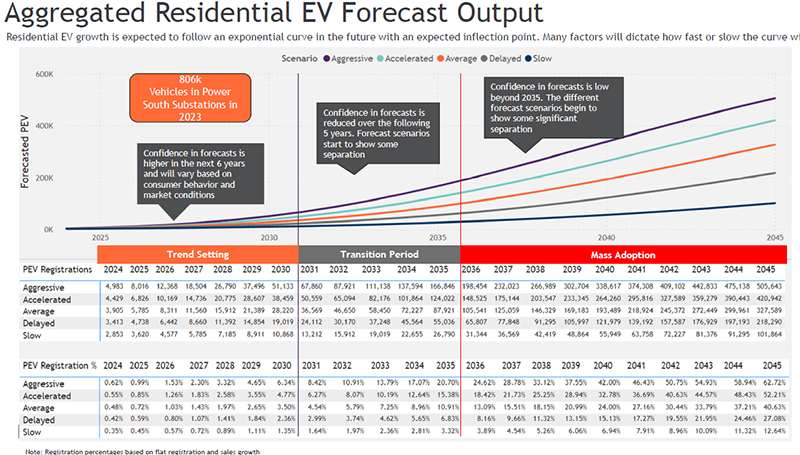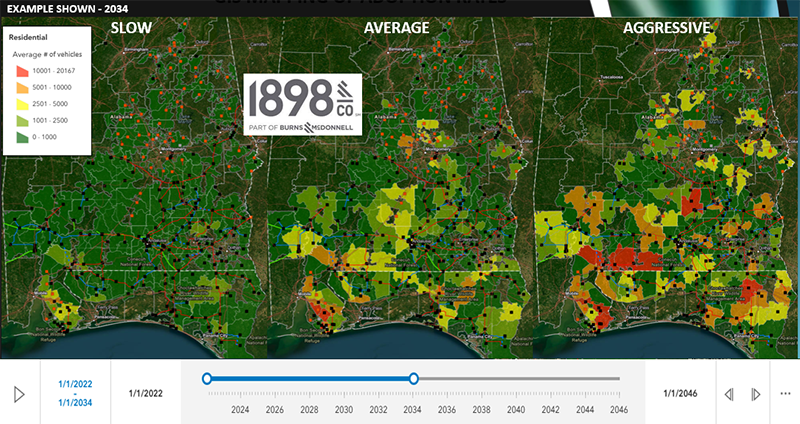Electric Cooperatives Leading the Charge on EV Adoption

Electric vehicles (EVs) are transforming the energy landscape and electric cooperatives are playing a vital role in managing this change, particularly in rural communities. As EV adoption expands beyond urban centers into rural areas, cooperative executives are examining how and where EV growth may impact their systems, operations and members.
Greater EV adoption translates to increased electricity sales and demand implications. This can impact distribution infrastructure, including transformers and substations. PowerSouth Energy Cooperative (PowerSouth), based in Andalusia, Alabama, is a generation and transmission (G&T) cooperative that provides wholesale power to 16 electric cooperatives and four municipal electric systems in Alabama and northwest Florida. Recognizing the potential impact of EV adoption, PowerSouth’s board prioritized a proactive approach.
“Our board saw this as a system planning priority and wanted to stay ahead of the technology curve,” PowerSouth Member Services Coordinator Mike Majors said. “We started with a broad focus on EV adoption within our territory, with plans to drill down to impacts on individual substations and our members.”

PowerSouth forged several key partnerships to address EV adoption. The cooperative is a member of the University of Alabama Mobility and Power Center and the Electric Power Research Institute (EPRI). They also collaborate with the State of Alabama’s Electric Vehicle Working Group and with the Florida Department of Transportation. Work with both organizations has centered on each state’s development of their National Electric Vehicle Infrastructure (NEVI) implementation plans.
To evaluate grid capacity and identify necessary upgrades, PowerSouth engaged a consulting firm to develop a forward-looking EV adoption model based on lessons learned and data generated from its partnerships. The model, which includes five adoption scenarios extending through 2040, leverages Microsoft Power BI.

“The model allows us to adjust inputs as policies and EV technology evolve,” Majors said. “The model provides the flexibility to adjust each adoption scenario. For instance, we can use a slow adoption model as part of the analysis if the EV sales market slows, but, likewise, we can readjust to a faster adoption model if policies or mandates dictate increased adoption. It’s been vital at providing a method for us to identify substations that may need upgrades and target spending more effectively.”
Proactive solutions like time-of-use rates are also being explored to encourage off-peak charging and mitigate negative impacts on the grid.
The ripple effects of EV adoption extend to nearly every aspect of utility operations. Planning teams must assess future demand and strategically locate transmission and distribution infrastructure to support charging stations. Member services need to educate consumers on EV benefits, charging solutions and rate options. On the technical side, updated systems are required to integrate data from networked chargers and advanced metering infrastructure. Utilities may also need to invest in tools like distributed energy resource management systems (DERMS) as a possible way to manage EV charging load or vehicle grid integration effectively.
Rural cooperatives face unique challenges, as EV adoption rates can vary widely due to economic and geographic factors. This variability complicates planning but also creates opportunities for leadership. By engaging members, piloting programs in underserved areas, and partnering with universities, research institutions and EV manufacturers, cooperatives can drive adoption and ensure equitable benefits for all members.
Electric cooperative executives face a critical moment to plan for and shape the EV era. Those who act decisively will safeguard reliability and affordability for their members while positioning themselves as leaders in clean transportation.